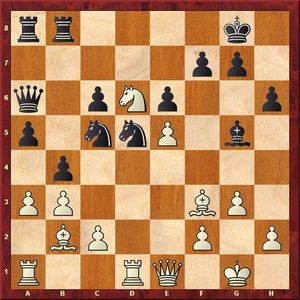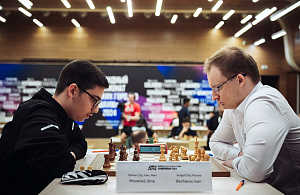11 September 2015
Queen flew into a rage
IM Vladimir Barsky reviews the sixth round of the World U20 Championships.
This day the open section got a new leader: after a slow start the Elo favorite Jan-Krzysztof Duda (Poland) came back on the first table and beat Karen Grigoryan from Armenia.
Duda – Grigoryan

In the Four Knights Game opponents got an original position already to the 10th move. It was also very complicated, with all pieces still on the board. Both GMs spent a lot of time thinking. In this position, Duda, having spent 16 minutes of the remaining 22, took the central pawn.
21.Nxe5!?
The Polish GM told that he saw Black's following combination, but decided to allow it. However, he almost did not analyze the alternative 21.g4 (the computer likes it). Perhaps, it was reasonable: after 21...Nfd6 22.Nxe5 (22.Ng3!?) 22...Nf7 it is hard to calculate complicated variations, but there is also a quite irrational way: 21...Bc7 22.f4!? (well, who would play so?) 22...exf4 23.Nexf4 Bd7 24.gxf5 Rxf5, and Black has compensation for a piece, because White's king is weak.
21...d3! 22.Ng4
It is clear that the pawn cannot be taken: 22.Bxd3? Qxh2+! 23.Kxh2 Rh6+, mating with the next move.
22...dxe2 23.Nxh6+ Rxh6 24.Rf2
Duda does not hold to extra material, preferring the initiative.
24...Bxf2 25.Qxf2 Rxd2 26.Qc5
After 26.Rc1 follows 26...Nd4, and the bishop still has to be given up, because if it retreats, a check from d1 follows. Now White threatens to checkmate next move.
26...Ned6
26...Rf6 is another option, but who wants to take a rook away from an active position?
27.Qa5
White has to give up the bishop (27.Rc1 Rxc2), but the Polish GM foresaw it.
27...Rxc2 28.Qd8+ Kf7 29.Qc7+ Ke8 30.Re1
Worse is 30.Bxd6 Rd2 31.Re1 Nxd6, and Black wins back a piece.
30...Rd2 31.Kg1

Technically Black has a material advantage - the rook and two knights against the queen. However, the queen on c7 is very strong, it can crush the opponent's army alone! In addition, Black's minor pieces have no good outposts in the center, the bishop is blocked by white pawns, and the e2-pawn should be given up soon. It seems that Duda correctly assessed the results of tactical complications: Black's position is worse.
31...Rd1
Grigoryan starts losing the track of the game. There was no point to part with an active rook, because he could have captured a pawn at least. After 31...Bd7 (protecting the knight d6 once again) 32.Kf2 Rxa2 33.Rxe2+ Rxe2+ 34.Kxe2 b6 35.Qxa7 Nc8 Black builds a defensive fortress on the queenside, which is not easy to break.
32.Kf2 Rxe1 33.Kxe1 Nc8
Now Black has no time to relocate his pieces: after 33...Bd7 follows 34.g4, and he loses the knight.
34.Kxe2 Bd7 35.Qxb7 Rxh2 36.Kf2 Rh6 37.Bc5 Nfd6 38.Qb8!
White gradually undermines the opponent's defense and wins the second pawn on the queenside, avoiding trading the bishop for the knight. Black's minor pieces are poorly placed and badly coordinated.
38...a6 39.Qa8 Rf6
Black threatens with a one-move fork on e4, but White keeps watch.
40.Kg1 a5 41.Bd4 Rg6 42.Qxa5 Nf5 43.Bf2 Rd6 44.Qe1+ Kf7 45.Bc5 Re6 46.Qd2 Ke8 47.a4
Finally the passed pawn starts moving.
47...Nfd6 48.Ba3 Black resigns.
Jan-Krzysztof was a bit surprised at his opponent’s decision: "I would have continued to defend in such position. Perhaps Grigoryan decided to save energy for the next games."
After this victory Duda became leader, but not a sole - together with Jorden Van Foreest from Holland.
Van Foreest - Bai Jinshi

An interesting theoretical duel in the Paulsen Variation: in the opening White sacrificed a pawn for developing his pieces on active squares. In the diagrammed position White has a decisive advantage by all appearances.
20.g4!
As we will see soon, it is important to give white queen access to the h5-square.
20...fxg4
20...Rf8 does not help because of 21.gxf5 Rxf5 22.Qxf5 Qxd6 23.Qxh7+, and White has a powerful attack while being equal on material. The game may continue 23...Kf8 24.Qh8+ Kf7 25.Qh5+ Kg8 26.Qh4! (eyeing the e7-rook, White creates a threat of Rd1) 26…Re8 (26...Bd5 brings no relief - 27.Bd3 e5 28.c4) 27.Qh8+ Kf7 28.Qh5+ Kf8 29.Qg5 etc.
21.Rxe6! dxe6
After 21...Qxe5 22.Rxe7+ Qd5 23.Bxd5+ Bxd5 24.Rxd7 Black loses an exchange.
22.Bxe6+ Kf8
22...Kh8 is answered by 23.Rxh7+! Kxh7 24.Qh5#; that is what the preparative move 20.g4! was for. After the text-move White also reaches the opponent's king.
23.Rxh7 Rd7 24.Rh8+ Ke7 25.Qxg7+ Kxe6 26.Qxg4+ Ke7 27.Qg5+ Kf7 28.Rh7+ Ke6 29.Rh6+ Black resigns.
Gordievsky – Laurusas

The vice-champion of the Russian Junior Championship easily overplayed his opponent. Black pieces are crowded on the queenside, the knight on c5 is out of play. White manages to use all these factors.
23.Bd4! Qb6
After the knight's retreat 23...Nd7 follows 24.Be2!, and the black queen is in trouble.
24.h4 Be7 25.Bxd5 cxd5 26.axb4 axb4 27.Qe3
The pin decides the game.
27...Rxa1 28.Rxa1 Bxd6 29.exd6 Qxd6 30.Be5 Black resigns.
After six rounds Zhansaya Abdumalik from Kazakhstan continues leading with 6 points! In the sixth round, as well as a day before, her game ended after approximately 20 moves because of the opponent's bad blunder.
Abdumalik – Buksa

The Ukrainian chess player has demonstrated very interesting opening play, she sacrificed a piece for two pawns and got a serious compensation. Black's threats on h-file are very dangerous. After an ordinary developing move 21...Be6 the fight would just has started; White should likely give back a piece on g3 or f4. However, Buksa probably miscalculated that she could win at once.
21...g4?
Now after 22.Nxf4 Qh4 23.Nh3 gxh3 or 22.Bxf4 Rh1+! 23.Kxh1 Qh4+ Black really wins. However, after 22.Rxf4 she has to resign: there is no checkmate in 22...Rh1+ 23.Kxh1 Qh4+ 24.Kg1 Qh2+ 25.Kf1 Qh1+ 26.Ng1.
Bivol – Drogovoz

The duel of two Russian girls turned out to be exciting. In the opening White gave up a bishop for two pawns: it was a very interesting, but not entirely sound sacrifice. Later Bivol overplayed her opponent and created dangerous threats on the kingside.
28.Rf6! Bxf6?
It is a case when they say: "This is chess, not checkers - it s not required to capture all the time!" After 28...Nd4 29.Nc4 White attacks, but Black can fight back well.
29.Rxf6 Re7
After 29...Bg8 30.Rxh6+ Bh7 White has a quite spectacular win: 31.e6! Rxe6 32.Qf5!
30.Nf5!
Perhaps Irina overlooked this nice knight's leap, counting only on 30.Rxh6+ Rh7 or 30.Qxh6+ Rh7 31.Rf8+ Bg8 32.Qf6+ Qg7. It is fair to say that in the second variation after 33.Ng4! Qxf6 34.Nxf6 Rg7 35.Re8! Black also has a difficult position: she cannot make away with a pin, and White simply rolls her pawns.
30...Rh7
Or 30...Bxf5 31.Qxh6+ Rh7 32.Rf8#.
31.Rf8+ Bg8 32.Qg6 Rg7 33.Qxh6+ Rh7 34.Qf6+ Rg7 35.e6 Black resigns.






















